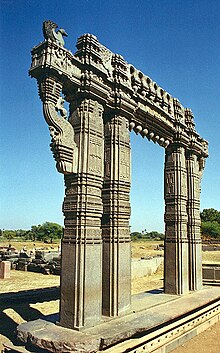| Part of a series on the |
| Telangana culture |
|---|
 |
| Part of a series on |
| Telangana |
|---|
| History and Kingdoms |
The history of Telangana, located on the high Deccan Plateau, includes its being ruled by the Satavahana Dynasty (230 BCE to 220 CE), the Kakatiya Dynasty (1083–1323), the Musunuri Nayaks (1326–1356), the Delhi Sultanate, the Bahmani Sultanate (1347–1512), Golconda Sultanate (1512–1687) and Asaf Jahi dynasty (1724–1950).[1]
In 1724, Nizam-ul-Mulk defeated Mubariz Khan and conquered Hyderabad. His successors ruled the princely state of Hyderabad, as Nizams of Hyderabad. The Nizams established first railways, postal and telegraph networks, and the first modern universities in Telangana.
After Indian independence, the Nizam did not sign the instrument of accession to India. The Indian army invaded and annexed Hyderabad State in 1948. From 1948 to 1956, Telangana remained as part of Hyderabad State, and then it was merged into Andhra Pradesh, a state created for Telugu people. In 2014, Telangana became the 29th state of India after the bifurcation of Andhra Pradesh, consisting of thirty-three (33) districts, with Hyderabad as its capital.[2] The city of Hyderabad served as the joint capital for the residual Andhra Pradesh and Telangana for a period of ten years until 2024.[3][4]
- ^ "Telangana History PDF". Bookinfo.
- ^ "Notification" (PDF). The Gazette of India. Government of India. 4 March 2014. Retrieved 4 March 2014.
- ^ "A brief history of Telangana". Business Standard Ltd. New Delhi. 1 June 2014. Retrieved 20 July 2014.
- ^ "Hyderabad no longer joint capital of Andhra Pradesh, Telangana from today". India Today. 2 June 2024. Retrieved 11 September 2024.